|
|
NYSG's Social Media Review: Late July 2016
By Paul F on Jul 22, 2016 at 11:46 AM
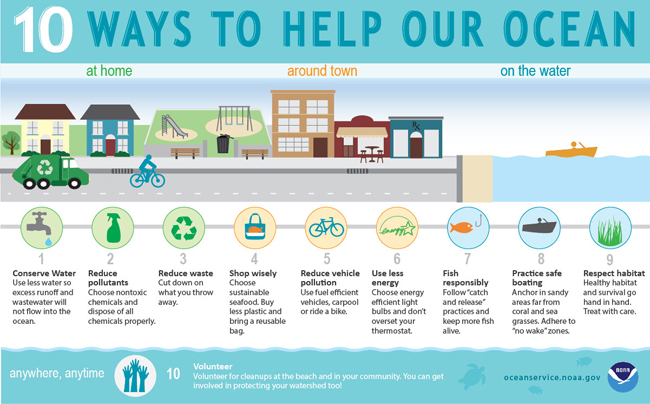
Ocean education has been a recent trending topic on social media for The National Oceanic and Atmospheric Administration (Sea Grant's federal parent agency). As seen in the infographic above, there are 10 things you can do to help our ocean. As NOAA's National Ocean Service reminds, your actions can make a difference: oceanservice.noaa.gov/ocean.
In News from NOAA's New York Sea Grant ...
(1) Our Summer 2016 issue of NY Coastlines / Currents was e-distributed on Friday, July 8th. If you're not one of the nearly 40% of our subscribers who have viewed its contents, be sure to check your inbox and check it out. The issue and its stories will soon be live on our Web site at www.nyseagrant.org/nycoastlines, where you can also currently sign up so that you'll receive our next issue. slated for release this fall.
(2) If you were the sitting Director of our coastal science research, extension and education program, where would you focus its energies, and why? NYSG's Director Bill Wise encourages folks to offer up their suggestions to us through the end of this month (July 2016): www.seagrant.sunysb.edu/articles/r/2648.
(3) The summer heat is a reminder to home gardeners about being water-wise with landscaping practices. Get tips on how everyday efforts can help reduce threats to water quality via our revised, full-color guide: www.seagrant.sunysb.edu/articles/r/2639.
(4) An application deadline has been set for Friday, September 23rd for grants of up to $25,000 that will be awarded via NYSG and the New York Department of Environmental Conservation for projects that conserve and restore native fish and wildlife biodiversity and habitats or enhance community resiliency and ecosystem integrity within New York’s Great Lakes basin. See the listing "New York’s Great Lakes Basin Small Grants Program - 2016 Request for Proposals" at www.nyseagrant.org/proposals.
(5) Registration is available for several food safety training courses - both online and in-person - through our newly-revised Seafood and Technology Web site, www.nyseagrant.org/seafood.
(6) We continue our commemoration of Sea Grant 50, the year-long anniversary campaign, by featuring some related coastal effort milestones - both statewide and nationally - on our blog, www.nyseagrant.org/blog.
(7) A historic 7-foot round boat is our eye-catching "Clean and Safe Boating" educational vessel for 2016. The vessel is part of a season-long campaign that, since 2008, has educated over 650,000 boaters. For more, including some key safe and clean boating tips, see www.seagrant.sunysb.edu/articles/r/2645.
(8) Although mid-July's free public recreational offerings in NYC during The Waterfront Alliance's City of Water Day are past, there are opportunities at boathouses and other locations throughout the summer and fall seasons: www.seagrant.sunysb.edu/articles/r/2673. Find additional "NYSG in NYC" news at www.nyseagrant.org/nyc.
(9) As seen at recent summer screenings of NOAA Sea Grant's Coastal Storm Awareness Program's short documentary in Long Beach, NY, hurricane preparedness is key before a severe storm approaches. Learn more at www.nyseagrant.org/csap.
Top 10 Trending News Stories from NOAA ...
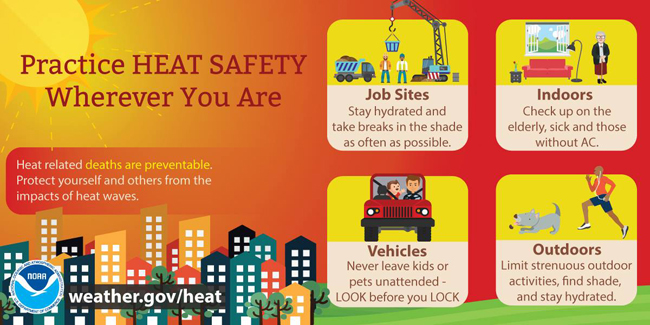
(1) HEAT SAFETY >>> Excessive heat is no joke and heat stroke is a medical emergency that requires a call to 911 and immediate medical attention. Know the signs and symptoms: www.nws.noaa.gov/om/heat/heat-illness.shtml. More at weather.gov/heatsafety or www.ready.gov/heat-toolkit.
Summer safety means more than just beating the heat, though, as seen in NOAA's "Weather Ready Nation" related resources, which also cover beach hazards (such as rip currents), severe weather (including hurricanes), lightning, air quality, floods and drought.
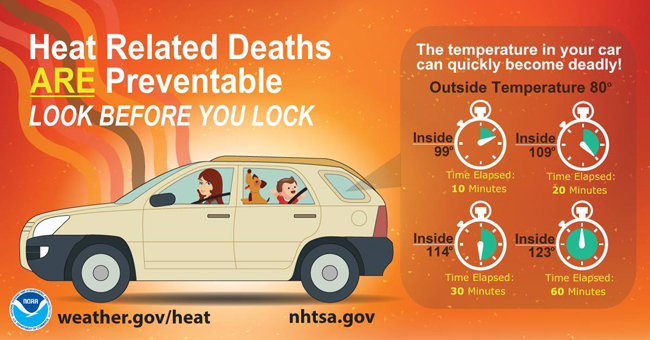
(2) SEVERE STORM RESOURCES >>> NOAA's National Hurricane Center offers up-to-date information on tropical cyclones and disturbances in the Atlantic Ocean at www.nhc.noaa.gov. NOAA's National Weather Service also offers forecasts, safety tips, weather-by-zip-code and more at www.weather.gov.
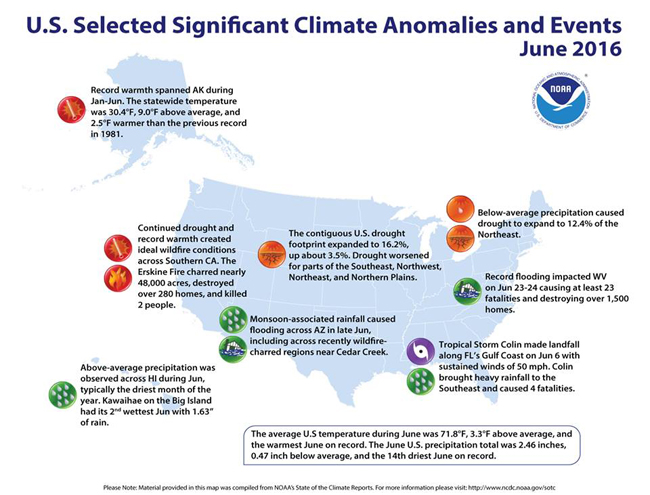
(3) U.S. & GLOBAL CLIMATE >>> According to the June 2016 Global Climate Report (bit.ly/29KNGkr), the temperature across global land and ocean surfaces for June 2016 was the highest for June since record keeping began in 1880. This marks the 14th consecutive month the monthly global temperature record has been broken, the longest such streak in the 137-year record.
ALSO: According to the June 2016 U.S. Climate Report (bit.ly/29xYXCV), the country experienced its warmest June on record. Above-average temperatures spanned the nation for the first six months of 2016, with every state being warmer than average. Overall, the contiguous U.S. was the third warmest on record.
(4) SWIM SAFE >>> It's hard to see and survive a rip current (you might know it as a "rip tide") when you don't know what to look for. Get a good look from the beach -- and the air in this NOAA Ocean Today video: oceantoday.noaa.gov/ripcurrentscience/welcome.html.
Also: Be aware of these 10 dangers at the beach: oceanservice.noaa.gov/news/jul14/beachdangers.html. And NYSG offers its related resources at www.nyseagrant.org/ripcurrents.
(5) WATER PROBLEMS >>> We're in the peak of summer, a season when droughts, heat waves, thunderstorms and tropical systems occur more frequently and at a higher intensity than any other time of the year. Extreme weather events like these not only put people and communities in great danger, they can also spell disaster for America’s water supply.
In a new blog post, NOAA Administrator Dr. Kathryn Sullivan discusses America's 21st century water problems and the latest scientific efforts to better understand and predict water in all its forms, from extreme floods to extreme droughts: bit.ly/2a2IGFr
(6) U.S. DISASTERS >>> At least $8 billion disasters have occurred in the United States so far this year that have tragically claimed 30 lives. See the list via NOAA National Centers for Environmental Information - Climate: bit.ly/29xc4pr.
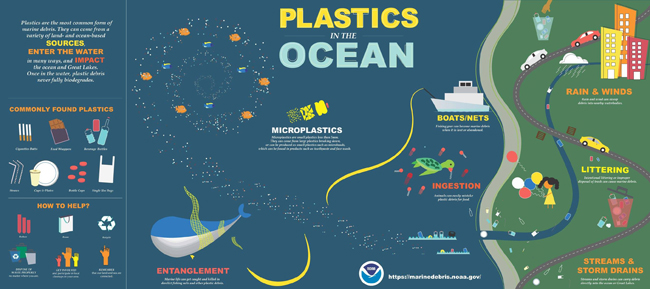
(7) MARINE DEBRIS >>> Don't let debris clutter your summer experiences. Here are some tips on how you break free from marine debris: bit.ly/29hgdxu.
ALSO: For more on what you can do to keep plastic out of our oceans: usresponserestoration.wordpress.com/2016/06/29/what-you-can-do-to-keep-plastic-out-of-the-ocean.
(8) U.S. DROUGHT >>> According to the July 19, 2016, U.S. Drought Monitor (bit.ly/2afoKQv), moderate to exceptional drought covers 18.8% of the contiguous United States, an increase from last week’s 17.7%. The worst drought categories (extreme to exceptional drought) also increased from 2.6% last week to 2.9%.
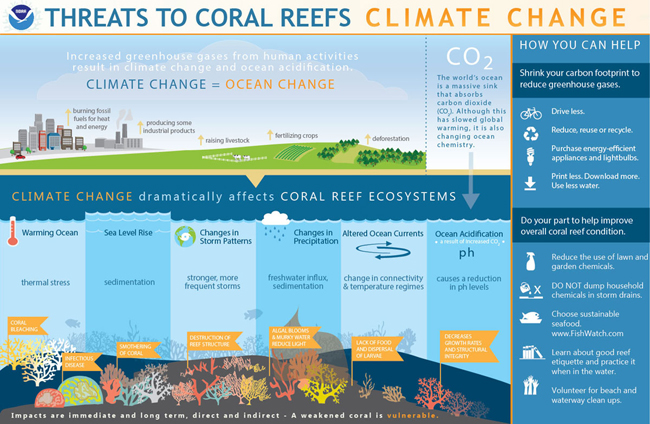
(9) CORAL BLEACHING >>> The release of Finding Dory brings coral reefs back into the public view. NOAA reports, "U.S. coral reefs facing warming waters, increased bleaching," www.noaa.gov/us-coral-reefs-facing-warming-waters-increased-bleaching.
ALSO: What happens when a coral bleaches? Find out in an episode of NOAA's National Ocean Service "Ocean Shorts," oceanservice.noaa.gov/podcast/sep15/os11-bleaching.html.
AND: How does climate change affect coral reefs?: oceanservice.noaa.gov/facts/coralreef-climate.html.
(10) OCEAN DEPTHS >>> How deep is the ocean? Satellites help us answer that question: go.usa.gov/cSMa8.
---
On www.nyseagrant.org ...
- Our "Trending Topics," such as climate change and green tips for coastal living, via a section on our homepage, www.nyseagrant.org.
- For the latest news from NYSG, check out our 'Currents' section, www.nyseagrant.org/currents, as well as our 'by-topic' archives, www.nyseagrant.org/currentsarchive.
- To keep tabs on all of NYSG's coastal science news, follow us on Facebook (www.facebook.com/nyseagrant), Twitter (www.twitter.com/nyseagrant) and YouTube (www.youtube.com/nyseagrant); Subscribe to our free news feeds (click the orange & white icon in the "Follow Us" navigation bar at www.nyseagrant.org); Sign up for our e-list in a few quick clicks at www.nyseagrant.org/nycoastlines. Our flagship publication, NY Coastlines / Currents, is published 1-2 times a year.
|